Indiana State is the 38th largest in the U.S., with an area of about 36,418 square miles. The state also goes by an official nickname, the Hoosier State.
Indiana is in the Midwestern United States, sharing borders with Illinois, Kentucky, Ohio, and Michigan.
Are you curious about the origin of the Indiana name or the Hoosier nickname? The origin of the two names is still to be determined. But a standard narrative opines the state got its identity from its native inhabitants, the Indians.
Indiana State was incorporated as one of the 50 states of the U.S. in December 1816. It is the 17th most populous state and had 6.806 million residents by 2021.
The City of South Bend is the snowiest place in Indiana.
Let’s explore this snowy city’s history, population, climate, and wildlife.
The History of the City of South Bend
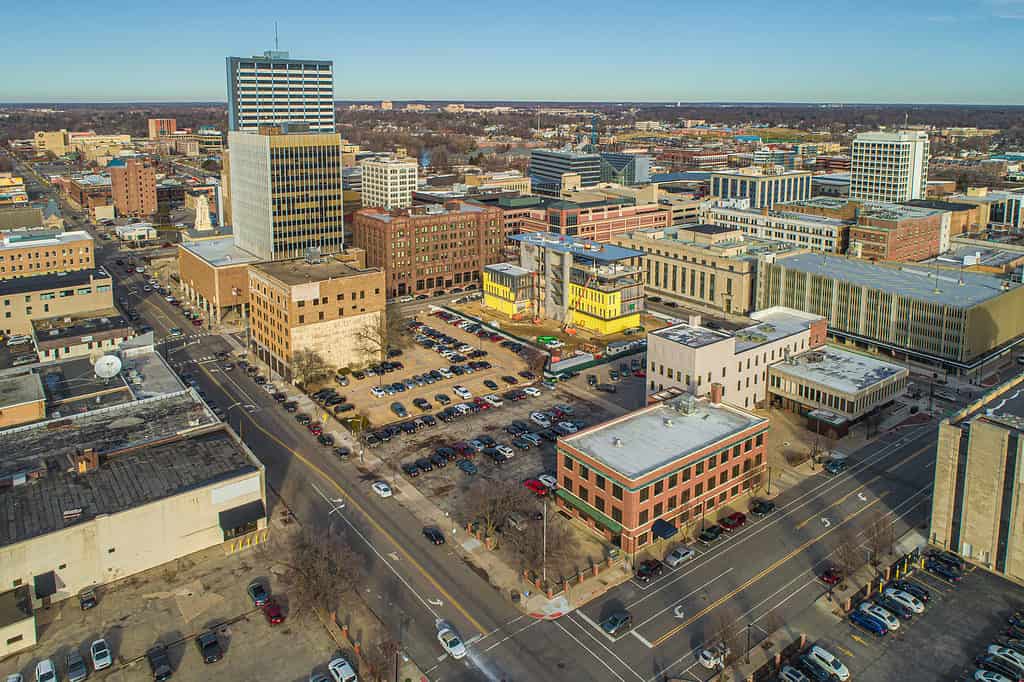
An aerial view of South Bend, Indiana, facing northeast.
©Aaron Yoder/Shutterstock.com
South Bend is the fourth largest in Indiana State, with an area of 41.46 square miles. It is on the extreme northern side of Indiana State, next to Mishawaka, about five miles from the Michigan border.
South Bend and Its Nicknames
Locals previously named South Bend “The Bend” due to its location on the southernmost bend of the St. Joseph River. In 1830, the government officially renamed the town South Bend, St. Joseph County, Indiana.
The city also goes by two nicknames, Wagon City and Lotion City. The nicknames were coined from the town’s many patent medicine- and wagon-making businesses at the time.
The Establishment of South Bend
Native Americans, the Miami tribe, were the first inhabitants of the Bend village. Later, Potawatomi would migrate to the area to utilize the natural resources available in the village. The variety of food crops growing along the St. Joseph River also attracted settlers.
Rene-Robert La Salle was the first French explorer to visit South Bend. In December 1679, La Salle signed the Miami Treaties with Native Americans, an agreement that saw many French settlers troop to the area. As a result, a rich French culture peppers South Bend’s history.
South Bend became popular in the same period for its quick and short portage overland route to the Kankakee River from the St. Joseph River. Years later, French explorers, missionaries, and traders would arrive in South Bend via the same route.
About twenty years after La Salle, a team of Catholic brothers settled in South Bend and established the famous University of Notre Dame in 1842. Around the 20th century, settlers set up fur trade businesses and consequently sparked industrial development in the area.
South Bend developed fast from the 1830s to 1850s as factories came up along both sides of the river. In 1851, the first steam locomotive ventured into South Bend. Major companies such as Studebaker Corporation, the world’s lead wagon manufacturer, and Bendix played a major role in the economic growth.
In May 1865, South Bend became a city, and in June of the same year, it held elections for the first time. In South Bend, you will also find the College Football Hall of Fame, which opened its doors for public displays in August 1995.
The Average Snowfall in South Bend
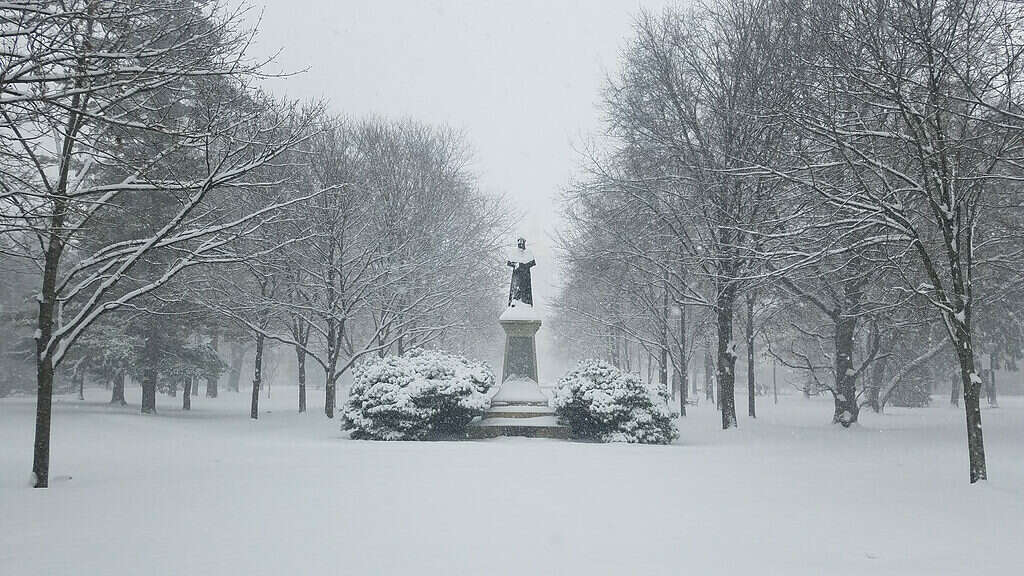
With the best of all four seasons, Indiana is capable of experiencing severe winters.
©Conor P. Fitzgerald/Shutterstock.com
Although Indiana State has the best of all four climate seasons, some places like South Bend record extreme winters. For example, from 1977 to 1978, Michiana, a region in South Bend, experienced an unforgettable and grueling winter. The city received 172 inches of snowfall, making it the snowiest winter in its history.
The runner-up tough winter season was from 1981 to 1982, when the snowfall was 135 inches deep. South Bend’s snowy season lasts about four and a half months—from mid-November to early April. Annually, South Bend receives an average of 64.5 inches of snow.
The city will likely get the highest amount of snow in the winter, about 4.5 inches. The city’s first snow usually falls in early November and the last in mid-April. It is also common for South Bend to experience major snowstorms every several years.
Other Climatic Conditions in South Bend
Generally, South Bend has a continental climate. Its summers are warm and enjoyable, and winters are cold and snowy. The city receives an average of 40 inches of rainfall evenly spread throughout the year. The summer season runs from late May to late September, with a daily average temperature of about 72 degrees Fahrenheit.
July is the hottest month, with an average low and high of 63 and 81 degrees Fahrenheit, respectively. So, if you plan a summer vacation in South Bend, schedule the time to fall within the 3.7 months of pleasant weather.
South Bend has a rather long winter with low temperatures that rarely rise above freezing. In winter, the precipitation falls in the form of snowfalls. If you are a thrill seeker interested in snowboarding, skiing, and other outdoor winter activities, visit the city from late December to March, the snowiest period.
The Number of People Living in South Bend

South Bend is Indiana’s fourth most populous city.
©Alexander Lukatskiy/Shutterstock.com
As Indiana State’s fourth most populous city, South Bend had a population of about 103,453 residents as per the 2020 census. The city is also the host of approximately 13,700 students and faculty, the total population of the famous University of Notre Dame.
In 1960, South Bend’s population peaked at 132,455 residents. Out of the total population, 75,074 were adults, of which 13,973 were seniors. After the 1960s, the population declined. By 1970, it had dropped by five percent.
The closure of major companies like Studebaker and Bendix in the 1960s was the leading cause of the population decline. The declining trajectory continued until the population was 101,166 in 2010. The population decrease earned the town a tag name, The Dying City, and also became a concern to the authorities.
The municipality developed academic, social, and economic policies to create a conducive environment to attract investors and increase the population. As a result, by 2020, the town had 103,453 residents, an increase of 0.44% from the previous census. The increase is evidence the city’s efforts to spark population growth have borne fruit.
Out of the total population of 103 453, about seven percent of residents are under five years, 26.9% are under 18, and 14% are 65 years and over. Females comprise 52.5%, while males are at 47.5%. The median age of the town is 33.7 years. By 2020, South Bend had 40,451 households, each with 2.46 occupants.
According to the U.S. American Community Survey’s data of 2009-2021, South Bend’s racial composition comprises:
- White (59.95%)
- Black (25.37%)
- Native Americans (0.48%)
- Asians (1.82%)
- Native Hawaiians (0.05%)
- Mixed race persons (6.99%)
- Other races (5.34%)
Wildlife in South Bend
The South Bend area has an animal control body, the Indiana Wildlife Commission or Indiana Fish & Wildlife Agency, which oversees all its wildlife management services. The body regulates hunting licenses, protects endangered species, and prevents poaching.
Some of South Bend’s wildlife, as recorded by the Indiana Wildlife Commission, include the Indiana state bird and state fish, the northern cardinal, and largemouth bass, respectively. Some of the most common wild animals you may find in South Bend include:
- Beavers
- Wild hogs
- Various bird species
- Raccoons
Beavers

The beaver is one of the most interesting animals to inhabit South Bend.
©CHRISTINA RADCLIFFE/Shutterstock.com
Though scarce in the state, this intriguing South Bend animal is famous for its lustrous fur and flat tail that’s regarded as a prize. Beavers create dams or ponds to build their homes, known as lodges, to protect themselves from predators.
Native Americans call beavers the sacred center because they create water resources.
The water catchment areas that beavers dig create an ecosystem that rivals tropical rainforests. The astounding beavers’ skills to create water sources are acquired, not inherent. The animal observes human activities to learn, copy, and imitate the process.
Wild Hogs
Wild hogs usually live in forested areas and have few predators, hence, their population can multiply to unmanageable levels that can destroy an entire farm of crops in a few days. In addition, wild hogs wreak havoc on farms and contaminate water sources.
Wild hogs are dangerous since they are bold, confrontational, and aggressive. Therefore, whenever the population is large and out of control, the community organizes a hunting season to reduce their number and curtail their destructive impact.
Birds
South Bend has abundant bird species living in the heavily wooded areas, prairies, wetlands, and around Worster Lake. The lake is the main attraction to birds, such as waterfowl, osprey, and bald eagles. In addition, the numerous bird species attract tourists interested in bird watching.
In South Bend, other birds like the scarlet tanager, geese, hawks, owls, and crows will be found there. Crows and geese are a nuisance to farmers since they can destroy seed crops. A high population of birds can destroy a bulk of seed crops within hours. In addition, some birds are peculiar since they dig out and eat seeds during planting seasons.
Raccoons
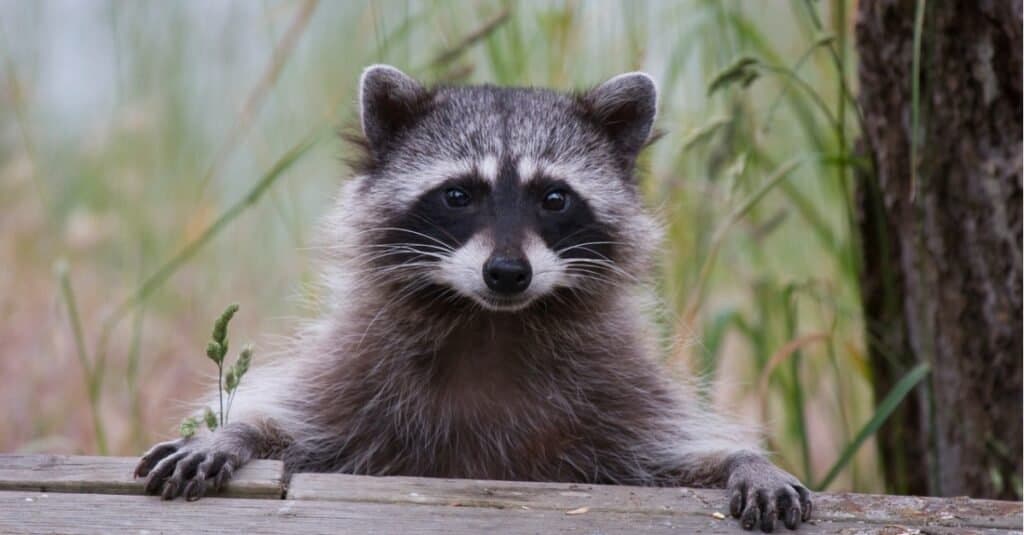
Raccoons are common in South Bend.
©iStock.com/cullenphotos
The raccoon is another common animal in South Bend. The animal likes to hibernate in the forest. If garbage or food is left outdoors, you will only find a raccoon in a homestead. It is also possible for raccoons to shelter in a home when it is about to have young ones, hence the need to secure buildings properly.
Red Foxes
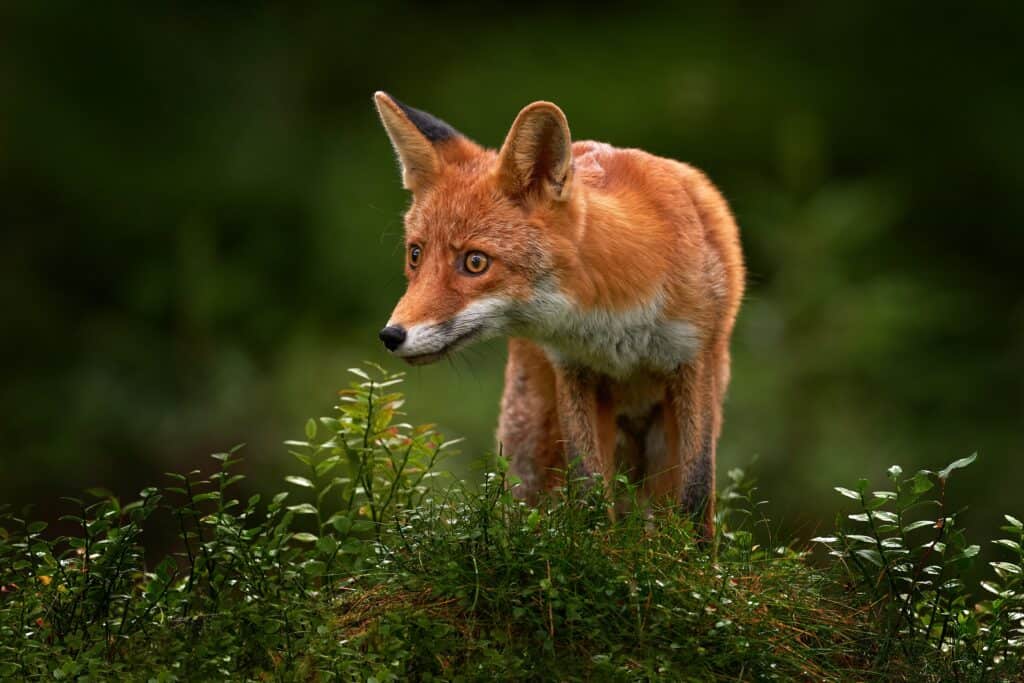
, the red fox, makes a large majority of the U.S. its home, including Indiana.
©Ondrej Prosicky/Shutterstock.com
Although found in South Bend and many parts of Indiana State, red foxes (known scientifically as Vulpes vulpes) are not native to the state. They were introduced here and to the rest of the U.S. from Europe. They moved here with European settlers in the mid-1800s. Red foxes are now common members of the Indiana wildlife community and are found in various habitats, including towns and cities.
Striped Skunks
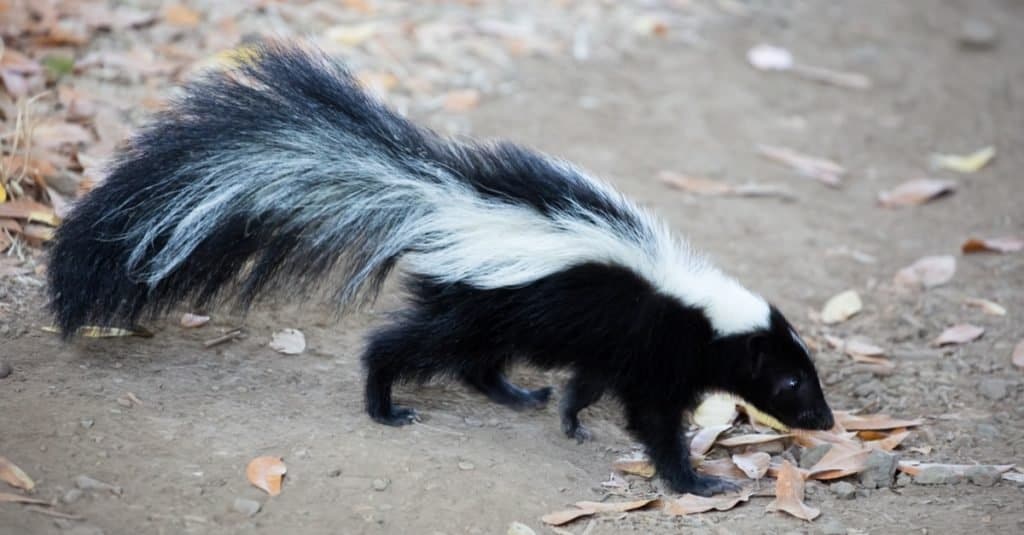
Like with many places in the United States, South Bend residents and visitors may see striped skunks around.
©yhelfman/Shutterstock.com
Striped skunks (known scientifically as Mephitis mephitis) are other distinctive members of Indiana’s wildlife community. Their conspicuous white and black color is their defense. Unfortunately, they also have a strong-smelling must that they spray when they feel threatened.
Other Animals Found in South Bend
In South Bend’s woods, you are likely to come across other animals, such as whitetail deer, bobcats, badgers, rattlers, coyotes, muskrats, and opossums, among many others.
Final Thoughts
Indiana State experiences the regular four seasons: summer, spring, fall, and winter. In winter, almost all of Indiana State snows, although snowfall levels differ from one area to the next. South Bend is the snowiest place in Indiana.
The city’s winters are pretty chilly with the average high hovering around freezing.
Up Next…
- Discover The Snowiest Cities in The United States
- The 5 States With the Most Dangerous Blizzards
- Discover the Snowiest Place in Alaska
The photo featured at the top of this post is © Jacob Boomsma/Shutterstock.com
Sources
- New America, Available here: https://www.newamerica.org/work-workers-technology/reports/automation-nation/south-bend-reinventing-a-dying-city/
- News Break, Available here: https://original.newsbreak.com/@diana-rus-561571/2825282712748-this-is-the-snowiest-town-in-indiana
- South Bend Elkhart, Available here: https://southbendelkhart.org/news/population-in-the-south-bend-elkhart-region-increased-1213-between-2018-and-2019/
- Wikipedia, Available here: https://en.wikipedia.org/wiki/South_Bend,_Indiana
Thank you for reading! Have some feedback for us? Contact the AZ Animals editorial team.






